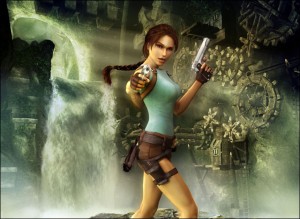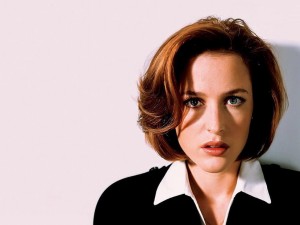 4. Buffy The Vampire Slayer – The “girl-next-door that is more capable than you giver her credit for” dynamic that Joss Whedon is so good at is in full bloom with the character of Buffy The Vampire Slayer…or more precisely, with Sarah Michelle Gellar’s portrayal.
4. Buffy The Vampire Slayer – The “girl-next-door that is more capable than you giver her credit for” dynamic that Joss Whedon is so good at is in full bloom with the character of Buffy The Vampire Slayer…or more precisely, with Sarah Michelle Gellar’s portrayal.
Nobody gave the show much of a prayer at the start. It was, after all, based on the movie which is seen as a dud. Kristy Swanson as Buffy, Paul (Pee-Wee) Reubens as a vampire, and Luke Perry as some guy that looks like Luke Perry just couldn’t make that odd, campy concept translate into a cult classic. But the television show, with a much better realization of a world where the earthbound and the hellborne intersect, not only justified the ludicrous pitch to make it a series, but firmly put flesh on the bones of this cottage industry Whedon now commands.
As unreal as Gellar’s Buffy could get, and the character could get pretty darn unreal, the viewer could see traits of young women they knew — sisters, friends, and even some of their own high school cheerleaders who probably were the least equipped to take on the forces of darkness. That is nonetheless the key to Buffy’s legion of fans and popularity, even after all these years off the air. It is also a cornerstone of Whedon’s seemingly universal philosophy, that the “least of these” will summon up the capacity to be the protector, even when nobody believes them capable. If that isn’t enough to win over a nerd/geek/four-eyes/poindexter/weirdo/outsider, nothing will.
 3. Lara Croft – Remember what I said about the dichotomy of “live” people versus animated or drawn people? Here’s an example for you. For a period of time, even in what is now a somewhat crude representation, Lara Croft, Tomb Raider became a sex symbol. Through a series of blockbuster video games, this femme fatale globe-trotting treasure hunter, the combination of an exaggerated digital babe kicking butt and scoring points became an interesting proposition. Certainly there were women gamers to whom this character of the go-get-em Croft was an instant idol, and shook up the dynamic where the woman in the game was always a princess to save.
3. Lara Croft – Remember what I said about the dichotomy of “live” people versus animated or drawn people? Here’s an example for you. For a period of time, even in what is now a somewhat crude representation, Lara Croft, Tomb Raider became a sex symbol. Through a series of blockbuster video games, this femme fatale globe-trotting treasure hunter, the combination of an exaggerated digital babe kicking butt and scoring points became an interesting proposition. Certainly there were women gamers to whom this character of the go-get-em Croft was an instant idol, and shook up the dynamic where the woman in the game was always a princess to save.
But guy gamers weren’t putting Lara Croft posters on their walls for her attributes as a role model. In the end, the male mind turns to room temperature butter in the presence of the female form. We wind up being pretty stupid that way. And I think there was a psychological aspect to Croft’s popularity among the boys — they could control her. It wasn’t a case of subjugation, but they were able to step outside of the gender thing and enjoy a game that was (let’s be honest) pretty darn fun. And it wasn’t scary or weird because Lara Croft was such a butt-kicker.
Notice that when the character transferred into the semi-real in the form of Angelina Jolie, at the peak of her popularity and box office drawing power, her two Tomb Raider films really didn’t shake much earth. That aspect of controlling Croft was gone. Instead there was Angelina, in all her unattainability, going through the motions. The game series has recently been relaunched, but the market is different now. With the most recent Bioshock game being hailed as one of the greatest ever made, going back to a sexy fortune hunter seems as regressive as it sounds.
 2. Agent Dana Scully – Speaking of gateway figures, here comes the perfect example of such in the form of FBI Agent Dana Scully, as played by Gillian Anderson on The X Files. She is the unbeliever when it comes to the paranormal shenanigans that rule her partner, Agent Fox Mulder’s, life. That allows him to talk about things that she, and we as viewers, need to know to move the story forward. Exposition, ahoy. Because she is the normal figure in the abnormal world, and she is inordinately attractive, we crush on her.
2. Agent Dana Scully – Speaking of gateway figures, here comes the perfect example of such in the form of FBI Agent Dana Scully, as played by Gillian Anderson on The X Files. She is the unbeliever when it comes to the paranormal shenanigans that rule her partner, Agent Fox Mulder’s, life. That allows him to talk about things that she, and we as viewers, need to know to move the story forward. Exposition, ahoy. Because she is the normal figure in the abnormal world, and she is inordinately attractive, we crush on her.
And it was extremely difficult not to crush on Scully. Anderson was something of an anomaly on TV, and certainly on the burgeoning Fox network where the only non-blonde on the roster was Peg Bundy. Scully was tough and analytical, but also emotionally vulnerable. She fought the ever-impending feeling of “wanting to believe,” to always rely on evidence over instinct and faith in that which could not be calculated, recreated or observed, and the character also tapped into creeping paranoia in the U.S. that our government was watching us, taking notes, and intruding.
It was this intermediary role that the character exemplified that made her so appealing to a viewership; those who might have had severe deficits in social skills. Scully had those deficits too and, in fact, Scully was probably more nerd than the nerds that idolized her. In early episodes she wants to have a relationship with someone normal (at least, more normal than partner Fox Mulder) and it was her clinical approach to life that scared suitors off. It was Mulder (David Duchovny) that was the hard-to-relate-to character as he traipsed off to the next unexplainable event with the fervor of a ’60s hippy on a vision quest. For the audience, Scully was more than a character — she kind of was one of them. And yes, she was sexy, but one feels awkward to even admit it under the circumstances.





Comments